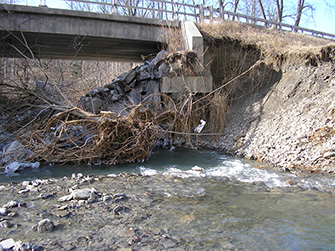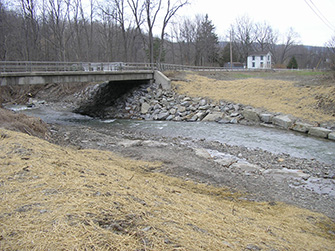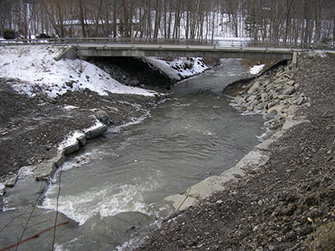Awards
Exemplary Ecosystem Initiatives — 2011
New York: New York State Route 34 over Cayuga Inlet

Figure 1. Significant bank erosion existed prior to improvements, creating worries about the safety and condition of the overlying bridge.
Source: New York State Department of Transportation
Inspections of the New York State Route 34 (SR 34) bridge over Cayuga Inlet, located five miles south of the city of Ithaca in Tompkins County, New York, served as the catalyst behind improvements to this structure and the surrounding environment. The New York SR 34 over Cayuga Inlet project reduced opportunities for future erosion by implementing an erosion-sensitive bridge design and directing water in the Cayuga Inlet away from the stream banks. The project also improved habitat conditions for fish and enhanced recreation opportunities for the public.
In early 2011, the New York State Department of Transportation (NYSDOT) discovered that multiple pilings of the SR 34 bridge over Cayuga Inlet were exposed due to bank erosion. In response, NYSDOT organized a task force with the New York State Department of Environmental Conservation (DEC) and the U.S. Fish and Wildlife Service (USFWS) to support restoration efforts. This interagency partnership collaborated to repair the stream banks, protect the bridge from future erosion, and develop an attractive wildlife habitat for fish and recreation uses.
USFWS developed a plan that reduced the amount of stress the stream placed upon the banks of the Cayuga Inlet to mitigate future erosion. NYSDOT implemented a design that limited the upstream continuation of head cuts, or sudden height shifts in stream beds that often form as erosion accelerates. NYSDOT recognized that limiting head cuts would be crucial to the future health of the bridge and stabilization of stream banks. The agency supported this by installing “cross vanes,” rock structures that control head cuts and direct flowing water toward the center of the channel, as well as a “J-Hook,” a grade control device used to mitigate erosion by guiding the course of the stream.
NYSDOT, USFWS, and DEC did not solely focus on improving the bridge's condition. As the Cayuga Inlet and its adjoining Cayuga Lake are significant habitats for migratory rainbow trout, the agencies strongly supported environmental restoration as part of this initiative. Bank erosion had added much silt and sediment to the stream. The installation of the “J-Hook” helped to limit this bank erosion and created “scour pools.” These small pools form downstream of the “J-Hook” and serve as aquatic habitats.
During the project, the agencies also focused on the safety of recreationalists and fishermen who frequent Cayuga Inlet and the lake. A formal parking area did not exist, so visiting recreationalists and fishermen were forced to park their vehicles along SR 34. DEC and USFWS collaborated to develop a vacant roadbed into a formal parking lot to improve safety and access to the waterfront. NYSDOT further supported this effort by integrating current work being performed by the Tompkins County Soil and Water District to hydro-seed this location.
Due to these interagency efforts, the SR 34 bridge over Cayuga Inlet and the inlet itself now benefit from protections against future erosion, bank stabilization, and habitat and recreational improvements.
For more information, contact Timothy Baker, New York State Department of Transportation, at tbaker@dot.state.ny.us.

Figure 2. Improvements to the State Route 34 bridge over Cayuga Inlet, including bank restoration and erosion mitigation
Source: New York State Department of Transportation

Figure 3. The implemented methods now channel water toward the center of the stream, away from the banks, to limit erosion.
Source: New York State Department of Transportation

